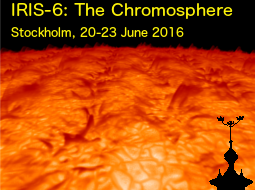Speaker
Ryohko Ishikawa
(National Astronomical Observatory of Japan)
Description
The Chromospheric Lyman-Alpha Spectro-Polarimeter (CLASP) is
a NASA sounding-rocket
experiment, which was launched from White Sands in the US on
September 3, 2015, and
successfully made the observations during its 5 minutes
ballistic flight. The CLASP
observations showed that the scattering polarization in the
hydrogen Lya line (121.57
nm), which originates in the upper chromosphere and
transition region, is about a few
percent in the wings and of the order of 0.1% in the core,
as had been theoretically
predicted, with the conspicuous spatial variations of ~10
arcsec. The behavior of the
wing polarization (i.e., the amplitude and clear
center-to-limb variation (CLV)) is
consistent with the theoretical prediction. However, the
line center polarization,
which via the Hanle effect is sensitive to magnetic field
strengths of 10-100 G, did
not show the CLV in the Q/I amplitude that is found when
solving the Lya scattering
polarization problem in the available 1D and 3D atmospheric
models. The additional
theoretical investigations that are being performed indicate
that this curious
feature of the CLASP observations can be understood in terms
of the magnetization
and/or geometrical complexity of the chromosphere-corona
transition region. It is
fortunate that one of channels covered the Si III line
(120.65 nm), which showed
measurable scattering polarization signals of a few %. This
polarization could
facilitate the interpretation of the scattering polarization
observed in the Lya
line, because it also originates in the upper chromosphere
and its critical field
strength for the Hanle effect is 295 G. By comparing the
signals observed in Lya and
the Si III line, we find some hints of the possible
operation of the Hanle effect in
an enhanced network region. CLASP also succeeded in
obtaining images of the Lya
intensity with a very high temporal cadence of 0.6 sec,
finding evidence of
ubiquitous high-frequency (
Primary author
Ryohko Ishikawa
(National Astronomical Observatory of Japan)

